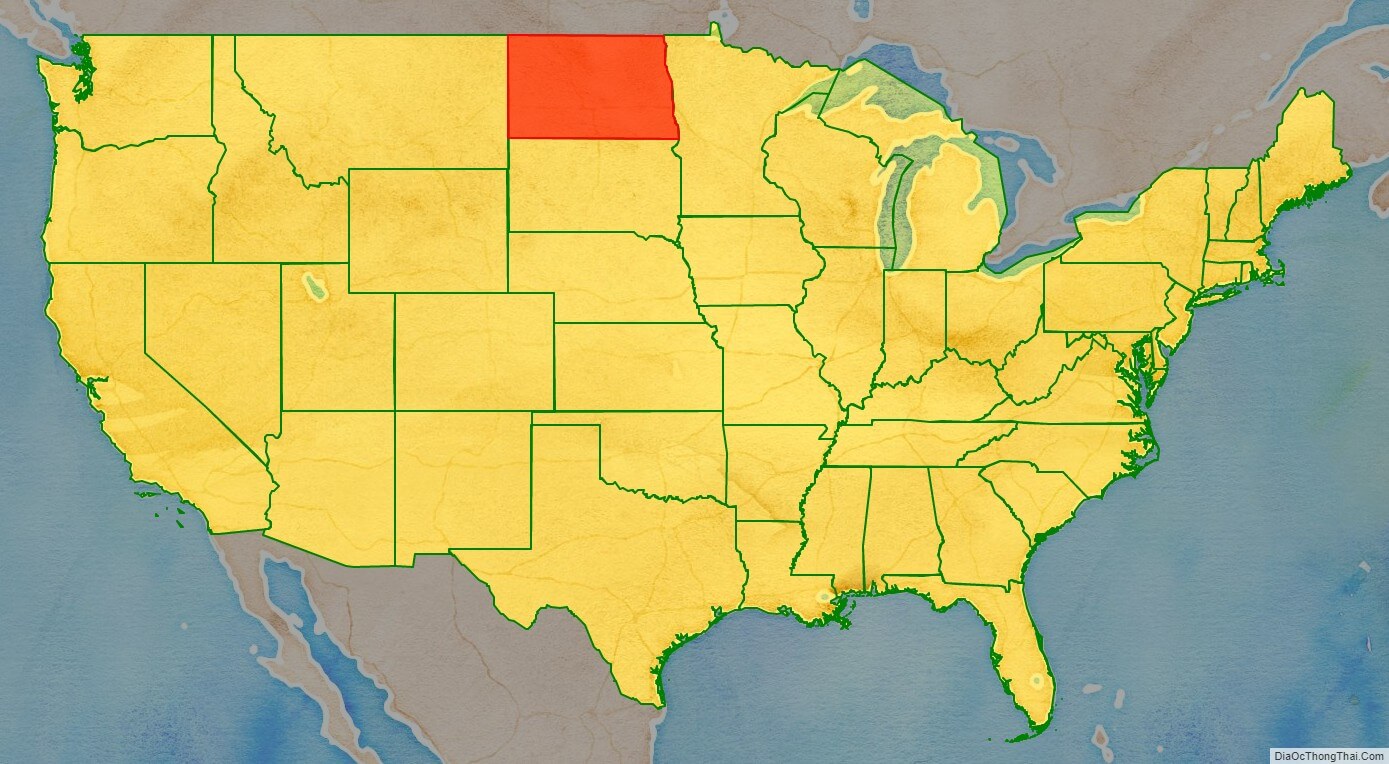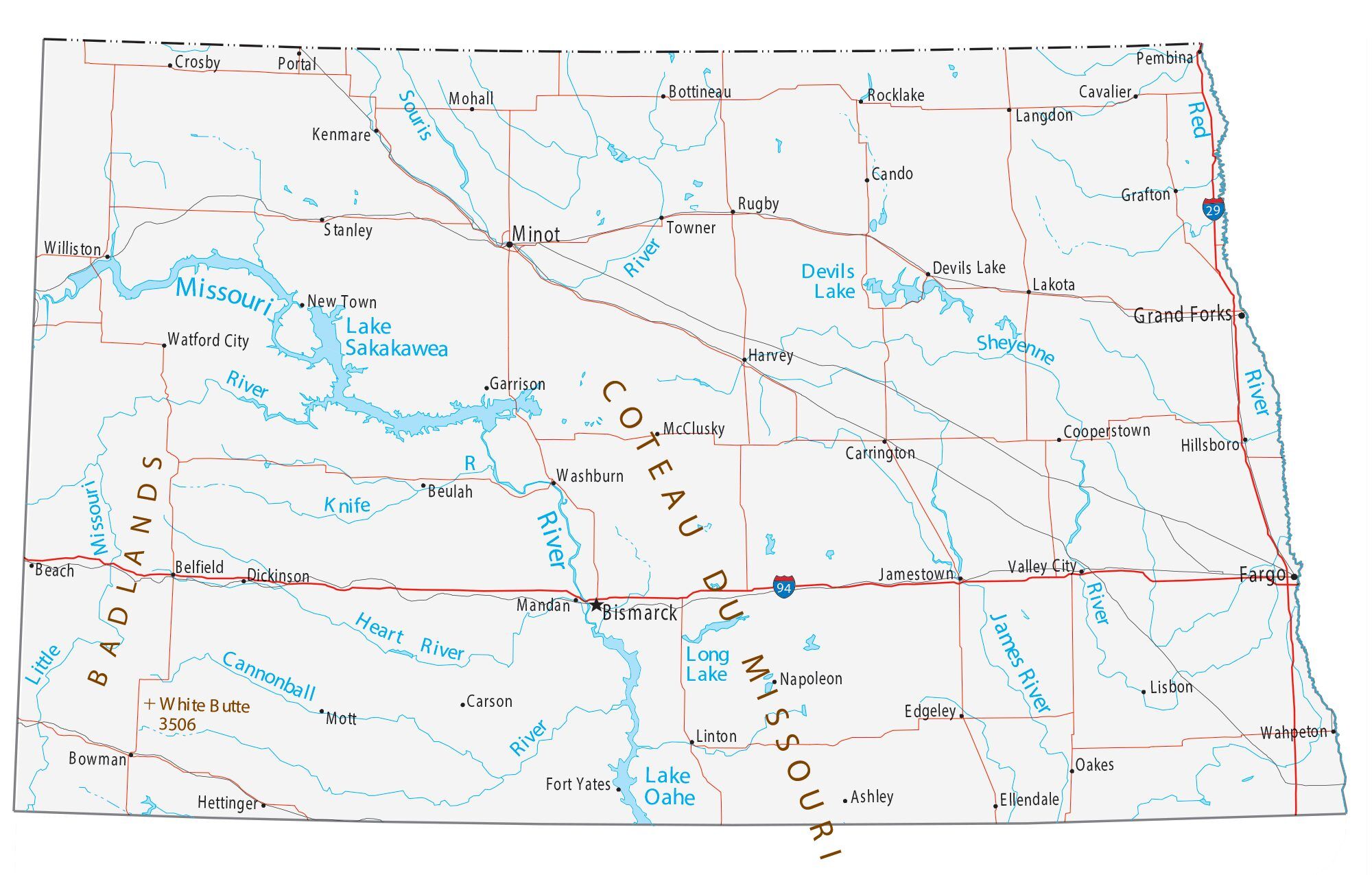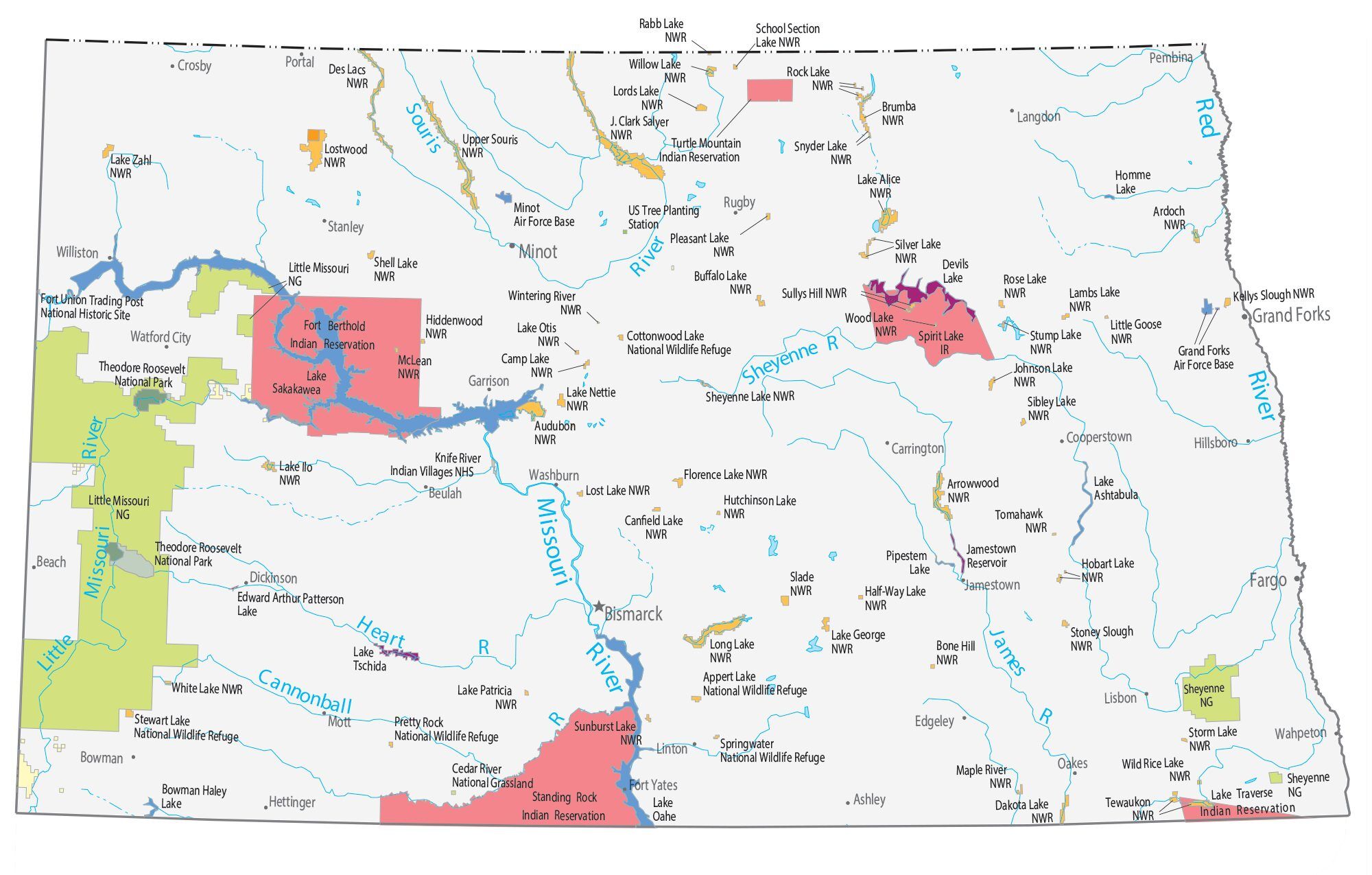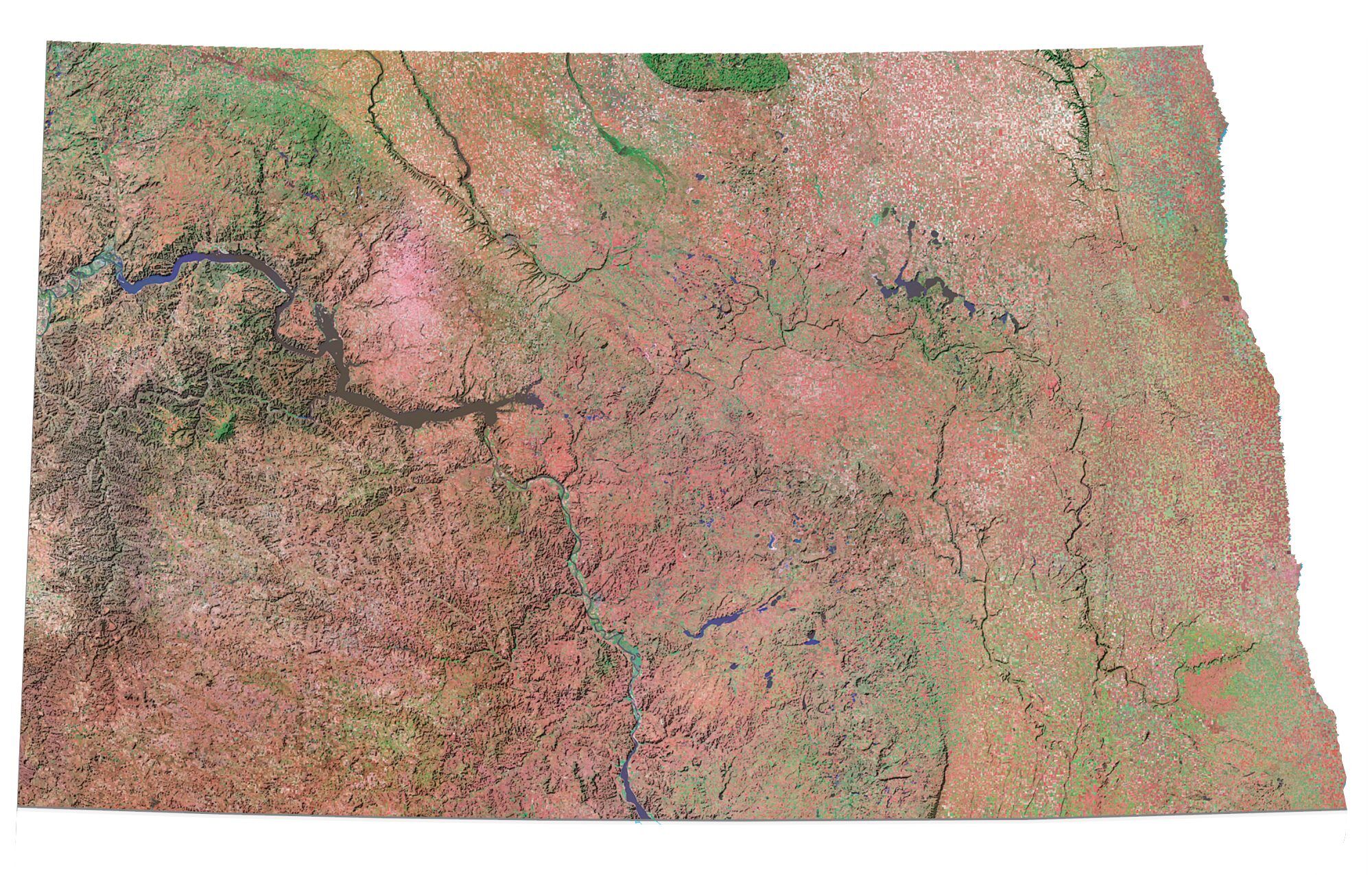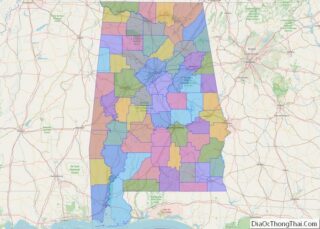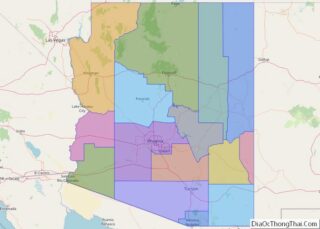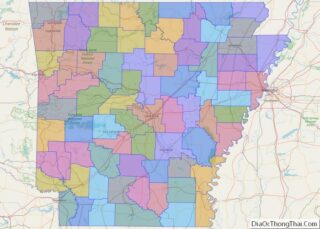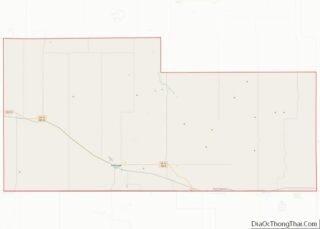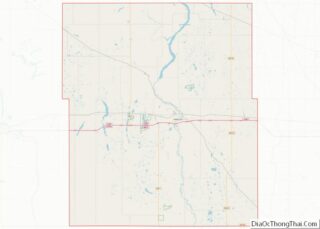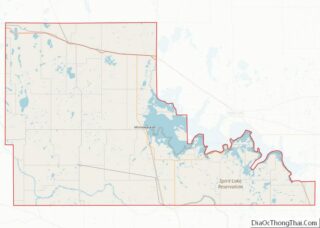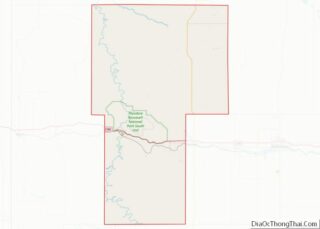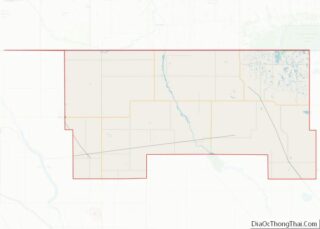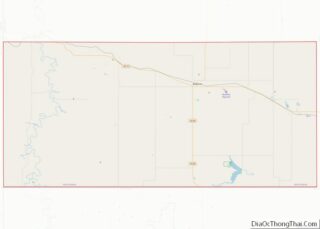North Dakota ( /- dəˈkoʊtə/ (listen)) is a U.S. state in the Upper Midwest, named after the indigenous Dakota Sioux. North Dakota is bordered by the Canadian provinces of Saskatchewan and Manitoba to the north and by the U.S. states of Minnesota to the east, South Dakota to the south, and Montana to the west. It is believed to host the geographic center of North America, Rugby, and is home to the tallest man-made structure in the Western Hemisphere, the KVLY-TV mast.
North Dakota is the 19th largest state, but with a population of less than 780,000 as of 2020, it is the 4th least populous and 4th most sparsely populated. The capital is Bismarck while the largest city is Fargo, which accounts for nearly a fifth of the state’s population; both cities are among the fastest-growing in the U.S., although half of all residents live in rural areas. The state is part of the Great Plains region, with broad prairies, steppe, temperate savanna, badlands, and farmland being defining characteristics.
What is now North Dakota was inhabited for thousands of years by various Native American tribes, including the Mandan, Hidatsa, and Arikara along the Missouri River; the Ojibwa and Cree in the northeast; and several Sioux groups (the Assiniboine, Yankton, Wahpeton, and Teton) across the rest of the state. European explorers and traders first arrived in the early 18th century, mostly in pursuit of lucrative furs. The United States acquired the region in the early 19th century, gradually settling it amid growing resistance by increasingly displaced natives.
The Dakota Territory, established in 1861, became central to American pioneers, with the Homestead Act of 1862 precipitating significant population growth and development. The traditional fur trade declined in favor of farming, particularly of wheat; the subsequent Dakota Boom from 1878 to 1886 saw giant farms stretched across the rolling prairies, with the territory becoming a key breadbasket and regional economic engine. The Northern Pacific and Great Northern railway companies competed for access to lucrative grain centers; farmers banded together in political and socioeconomic alliances that were core to the broader Populist Movement of the Midwest.
North Dakota was admitted to the Union on November 2, 1889, along with neighboring South Dakota, as the 39th and 40th states. President Benjamin Harrison shuffled the statehood papers before signing them so that no one could tell which became a state first; consequently, the two states are officially numbered in alphabetical order. Statehood marked the gradual winding down of the pioneer period, with the state fully settled by around 1920. Subsequent decades saw a rise in radical agrarian movements and economic cooperatives, of which one legacy is the Bank of North Dakota, the only state-run bank in the U.S.
Beginning in the mid 20th century, North Dakota’s rich natural resources became more critical to economic development; into the 21st century, oil extraction from the Bakken formation in the northwest has played a major role in the state’s prosperity. Such development has led to unprecedented population growth (along with high birth rates) and reduced unemployment, with North Dakota having the second lowest unemployment rate in the U.S. (after Hawaii). It ranks relatively well in metrics such as infrastructure, quality of life, economic opportunity, and public safety.
| Before statehood: | Dakota Territory |
|---|---|
| Admitted to the Union: | November 2, 1889 (39th) |
| Capital: | Bismarck |
| Largest city: | Fargo |
| Largest metro and urban areas: | Fargo |
| Elevation: | 1,900 ft (580 m) |
| Total Area: | 70,705 sq mi (183,123 km) |
| Area Rank: | 19th |
| Total Population: | 779,261 |
| Population Rank: | 47th |
| Population Density: | 10.73/sq mi (4.13/km) |
| Population Density Rank: | 47th |
| Median Household Income: | $61,843 |
| Income Rank: | 20th |
| Demonym(s): | North Dakotan |
| USPS abbreviation: | ND |
| ISO 3166 code: | US-ND |
| Website: | nd.gov |
Online Interactive Map
Click on ![]() to view map in "full screen" mode.
to view map in "full screen" mode.
North Dakota location map. Where is North Dakota state?
North Dakota Road Map
North Dakota Map – Roads & Cities
North Dakota Street Map
History
Pre-colonial history
Native American people lived in what is now North Dakota for thousands of years before the arrival of Europeans. The known tribes included the Mandan people (from around the 11th century), while the first Hidatsa group arrived a few hundred years later. They both assembled in villages on tributaries of the Missouri River in what would become west-central North Dakota. Crow Indians traveled the plains from the west to visit and trade with the related Hidatsas after the split between them, probably in the 17th century.
Later came divisions of the Dakota people: the Lakota, the Santee and the Yanktonai. The Assiniboine and the Plains Cree undertook southward journeys to the village Indians, either for trade or for war. The Shoshone Indians in present-day Wyoming and Montana may have carried out attacks on Indian enemies as far east as the Missouri. A group of Cheyennes lived in a village of earth lodges at the lower Sheyenne River (Biesterfeldt Site) for decades in the 18th century.
Due to attacks by Crees, Assiniboines and Chippewas armed with fire weapons, they left the area around 1780 and crossed Missouri some time after. A band of the few Sotaio Indians lived east of Missouri River and met the uprooted Cheyennes before the end of the century. They soon followed the Cheyennes across Missouri and lived among them south of Cannonball River.
Eventually, the Cheyenne and the Sutaio became one tribe and turned into mounted buffalo hunters with ranges mainly outside North Dakota. Before the middle of the 19th century, the Arikara entered the future state from the south and joined the Mandan and Hidatsa. With time, a number of Indians entered into treaties with the United States. Many of the treaties defined the territory of a specific tribe.
European exploration and colonization
The first European to reach the area was the French-Canadian trader Pierre Gaultier, sieur de La Vérendrye, who led an exploration and trading party to the Mandan villages in 1738 guided by Assiniboine Indians.
From 1762 to 1802, the region formed part of Spanish Louisiana.
Settlement and statehood
European Americans settled in Dakota Territory only sparsely until the late 19th century, when railroads opened up the region. With the advantage of grants of land, they vigorously marketed their properties, extolling the region as ideal for agriculture.
Differences between the northern and southern part caused resentments between the settlers. The northern part was seen by the more populated southern part as somewhat disreputable, “too much controlled by the wild folks, cattle ranchers, fur traders” and too frequently the site of conflict with the indigenous population. The northern part was generally content with remaining a territory. However, following the territorial capital being moved from Yankton in the southern part to Bismarck, the southern part began to call for division. Finally, at the 1887 territorial election, the voters approved splitting the territory into two. The division was done by the seventh standard parallel.
Congress passed an omnibus bill for statehood for North Dakota, South Dakota, Montana, and Washington, titled the Enabling Act of 1889, on February 22, 1889, during the administration of President Grover Cleveland. His successor, Benjamin Harrison, signed the proclamations formally admitting North Dakota and South Dakota to the Union on November 2, 1889.
The rivalry between the two new states presented a dilemma of which was to be admitted first. Harrison directed Secretary of State James G. Blaine to shuffle the papers and obscure from him which he was signing first. The actual order went unrecorded, thus no one knows which of the Dakotas was admitted first. However, since North Dakota alphabetically appears before South Dakota, its proclamation was published first in the Statutes At Large.
20th and 21st centuries
Unrest among wheat farmers, especially among Norwegian immigrants, led to a populist political movement centered in the Non Partisan League (“NPL”) around the time of World War I. The NPL ran candidates on the Republican ticket (but merged into the Democratic Party after World War II). It tried to insulate North Dakota from the power of out-of-state banks and corporations.
In addition to founding the state-owned Bank of North Dakota and North Dakota Mill and Elevator (both still in existence), the NPL established a state-owned railroad line (later sold to the Soo Line Railroad). Anti-corporate laws virtually prohibited a corporation or bank from owning title to land zoned as farmland. These laws, still in force today, after having been upheld by state and federal courts, make it almost impossible to foreclose on farmland, as even after foreclosure, the property title cannot be held by a bank or mortgage company. Furthermore, the Bank of North Dakota, having powers similar to a Federal Reserve branch bank, exercised its power to limit the issuance of subprime mortgages and their collateralization in the form of derivative instruments, and so prevented a collapse of housing prices within the state in the wake of 2008’s financial crisis.
The original North Dakota State Capitol in Bismarck burned to the ground on December 28, 1930. It was replaced by a limestone-faced art-deco skyscraper that still stands today. A round of federal investment and construction projects began in the 1950s, including the Garrison Dam and the Minot and Grand Forks Air Force bases.
Western North Dakota saw a boom in oil exploration in the late 1970s and early 1980s, as rising petroleum prices made development profitable. This boom came to an end after petroleum prices declined.
In recent years, the state has had lower rates of unemployment than the national average, and increased job and population growth. Much of the growth has been based on development of the Bakken oil fields in the western part of the state. Estimates as to the remaining amount of oil in the area vary, with some estimating over 100 years’ worth.
For decades, North Dakota’s annual murder and violent crime rates were regularly the lowest in the United States. In recent years, however, while still below the national average, crime has risen sharply. In 2016, the violent crime rate was three times higher than in 2004, with the rise occurring mostly in the late 2000s, coinciding with the oil boom era. This happened at a time when the national violent crime rate declined slightly. Workers in the oil boom towns have been blamed for much of the increase.
North Dakota State Map – Places and Landmarks
North Dakota Political Map
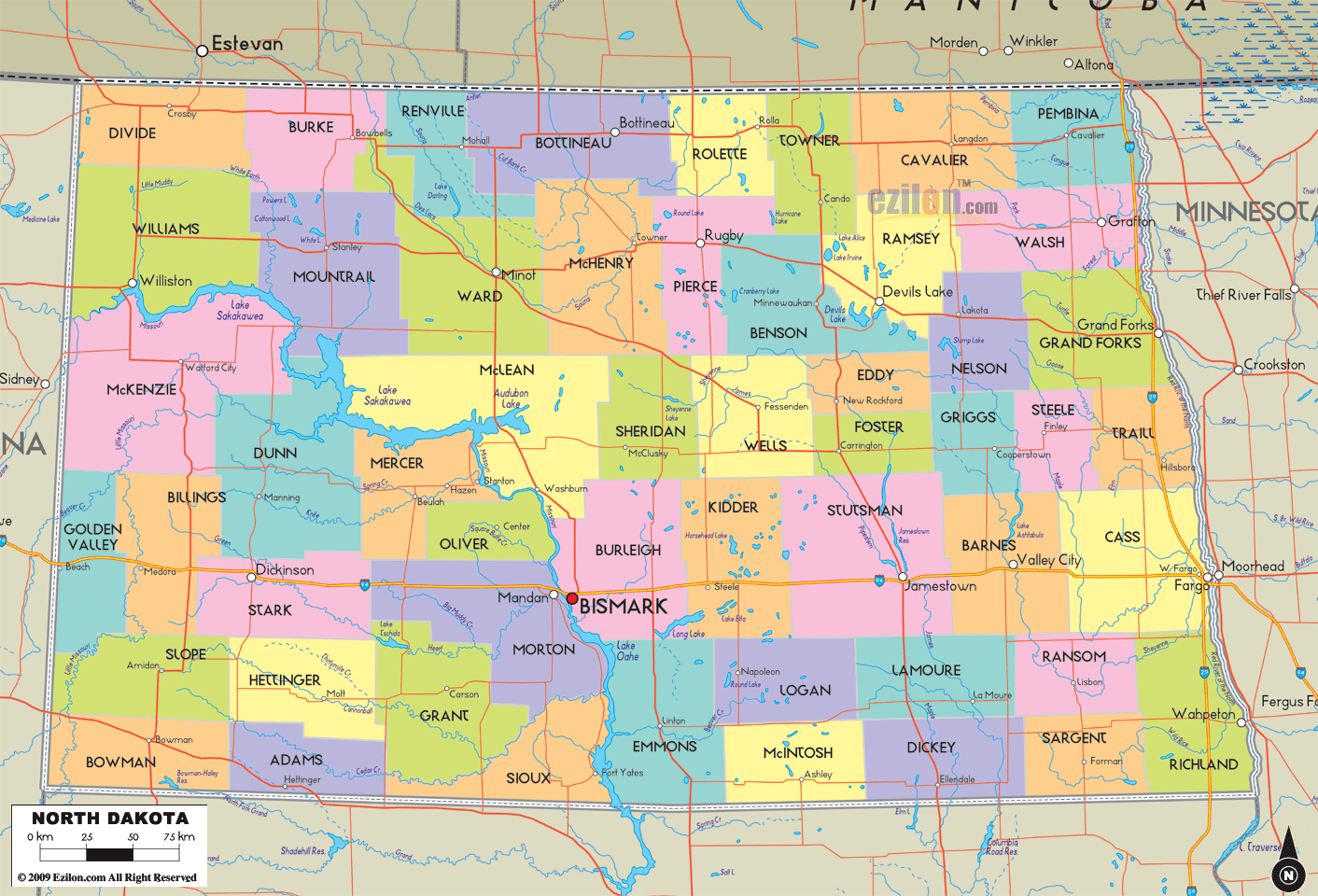
North Dakota Lakes and Rivers Map
Geography
North Dakota is located in the Upper Midwest region of the United States. It lies at the center of the North American continent and borders Canada to the north. The geographic center of North America is near the town of Center. Bismarck is the capital of North Dakota, and Fargo is the largest city.
Soil is North Dakota’s most precious resource. It is the base of the state’s great agricultural wealth. North Dakota also has enormous mineral resources. These mineral resources include billions of tons of lignite coal. In addition, North Dakota has large oil reserves. Petroleum was discovered in the state in 1951 and quickly became one of North Dakota’s most valuable mineral resources. In the early 2000s, the emergence of hydraulic fracturing technologies enabled mining companies to extract huge amounts of oil from the Bakken shale rock formation in the western part of the state.
North Dakota’s economy is based more heavily on farming than the economies of most other states. Many North Dakota factories process farm products or manufacture farm equipment. Many of the state’s merchants also rely on agriculture. North Dakota 2022 Economic Outlook Rank: 9th Economic Performance Rank Rank: 14th. The pandemic also triggered mass job losses in the state. Though North Dakota’s unemployment rate of 4.4% is below the 6.0% national rate, it is nearly double what it was this time last year.
Farms and ranches cover nearly all of North Dakota. They stretch from the flat Red River Valley in the east, across rolling plains, to the rugged Badlands in the west. The chief crop, wheat, is grown in nearly every county. North Dakota harvests more than 90 percent of the nation’s canola and flaxseed. It is also the country’s top producer of barley and sunflower seeds and a leader in the production of beans, honey, lentils, oats, peas, and sugar beets.
Few white settlers came to the North Dakota region before the 1870s because railroads had not yet entered the area. During the early 1870s, the Northern Pacific Railroad began to push across the Dakota Territory. Large-scale farming also began during the 1870s. Eastern corporations and some families established huge wheat farms covering large areas of land in the Red River Valley. The farms made such enormous profits they were called bonanza farms. White settlers, attracted by the success of the bonanza farms, flocked to North Dakota, rapidly increasing the territory’s population. In 1870, North Dakota had 2,405 people. By 1890, the population had grown to 190,983.
North Dakota was named for the Sioux people who once lived in the territory. The Sioux called themselves Dakota or Lakota, meaning allies or friends. One of North Dakota’s nicknames is the Peace Garden State. This nickname honors the International Peace Garden, which lies on the state’s border with Manitoba, Canada. North Dakota is also called the Flickertail State because of the many flickertail ground squirrels (Richardson’s ground squirrel) that live in the central part of the state.
North Dakota is in the U.S. region known as the Great Plains. The state shares the Red River of the North with Minnesota to the east. South Dakota is to the south, Montana is to the west, and the Canadian provinces of Saskatchewan and Manitoba are to the north. North Dakota is near the middle of North America with a stone marker in Rugby, North Dakota marking the “Geographic Center of the North American Continent”. With an area of 70,762 square miles (183,273 km), 69,001 square miles (178,712 km) of which is land, North Dakota is the 19th largest state.
The western half of the state consists of the hilly Great Plains as well as the northern part of the Badlands, which are to the west of the Missouri River. The state’s high point, White Butte at 3,506 feet (1,069 m), and Theodore Roosevelt National Park are in the Badlands. The region is abundant in fossil fuels including natural gas, crude oil and lignite coal. The Missouri River forms Lake Sakakawea, the third largest artificial lake in the United States, behind the Garrison Dam.
The central region of the state is divided into the Drift Prairie and the Missouri Plateau. The eastern part of the state consists of the flat Red River Valley, the bottom of glacial Lake Agassiz. Its fertile soil, drained by the meandering Red River flowing northward into Lake Winnipeg, supports a large agriculture industry. Devils Lake, the largest natural lake in the state, is also found in the east.
Most of the state is covered in grassland; crops cover most of eastern North Dakota but become increasingly sparse in the center and farther west. Natural trees in North Dakota are found usually where there is good drainage, such as the ravines and valley near the Pembina Gorge and Killdeer Mountains, the Turtle Mountains, the hills around Devils Lake, in the dunes area of McHenry County in central North Dakota, and along the Sheyenne Valley slopes and the Sheyenne delta. This diverse terrain supports nearly 2,000 species of plants.
North Dakota public lands 5 national parks, 5 state forests, 63 national wildlife refuges, 3 national grassland, and 13 state parks plus there are state trust land, bureau of land management, waterfowl production areas, bureau of reclamation, bureau of land management, U.S. Army Corps of Engineers, state wildlife management areas
North Dakota wildlife
Currently there are 36 Level I species, 44 Level II species, and 35 Level III species.
List of birds of North Dakota The basic NDGFD list contains 420 confirmed and extant species, two extinct species. Three additional species have been added from the North Dakota Bird Records Committee (NDBRC) review list with some additions from Avibase. The combined lists contain 420 species. Of them, 194 and a subspecies are on the review list (see below). The NDGFD list considers 44 species to be accidental, and eight species have been introduced to North America.
List of mammals of North Dakota 87 species are known to live in the state. This includes mammals that are currently extirpated or locally extinct in North Dakota such as the gray wolf, swift fox, caribou and grizzly bear.
List of insects of North Dakota 1,126 Species known in North Dakota
List of fish of North Dakota 98 Species are currently known in North Dakota
List of reptiles/amphibians of North Dakota 16 Species of Reptiles and 12 Amphibians found in the state.
List of crustaceans/mussels of North Dakota
Three species of crawfish are found in North Dakota: Devil, Calico, and Virile
North Dakota is home to three freshwater shrimp species, gammarus, hyalella and mysis. The latter is an introduced species stocked in Lake Sakakawea in the early 1970s to add to the forage base.
Cvancara’s Aquatic Mussels of North Dakota from 1983. He documented 13 species of what are generally referred to as clams in the state along with 13 species of pill clams, which are very small clams, in the order of a few millimeters in length. He also documented 22 species of snails in the state.
Climate
North Dakota has a continental climate with warm summers and cold winters. The temperature differences are significant because of its far inland position and being roughly equal distance from the North Pole and the Equator.
Monthly maximum and minimum temperatures (°F/°C) in North Dakota
North Dakota holds 12 hour temperature rise record
In 12 hours: 83°F, Granville, N.D., Feb. 21, 1918, from –33°F to 50°F from early morning to late afternoon.
Langdon, North Dakota, was the epicenter of the cold wave of 1936:
It remained below freezing (day and night) for 92 consecutive days, from November 30 through February 29 Langdon’s warmest February temperature was a frigid 15°
Langdon holds the record for: below 0° 41 consecutive days, January 11 though February 20. This is a record for any location in the contiguous U.S.
North Dakota Physical Map
North Dakota Topographic Map
North Dakota Satellite Map
Others printable maps
North Dakota Outline Map
Blank North Dakota County Map
See also
Map of North Dakota State and its subdivision:- Adams
- Barnes
- Benson
- Billings
- Bottineau
- Bowman
- Burke
- Burleigh
- Cass
- Cavalier
- Dickey
- Divide
- Dunn
- Eddy
- Emmons
- Foster
- Golden Valley
- Grand Forks
- Grant
- Griggs
- Hettinger
- Kidder
- Lamoure
- Logan
- McHenry
- McIntosh
- McKenzie
- McLean
- Mercer
- Morton
- Mountrail
- Nelson
- Oliver
- Pembina
- Pierce
- Ramsey
- Ransom
- Renville
- Richland
- Rolette
- Sargent
- Sheridan
- Sioux
- Slope
- Stark
- Steele
- Stutsman
- Towner
- Traill
- Walsh
- Ward
- Wells
- Williams
- Alabama
- Alaska
- Arizona
- Arkansas
- California
- Colorado
- Connecticut
- Delaware
- District of Columbia
- Florida
- Georgia
- Hawaii
- Idaho
- Illinois
- Indiana
- Iowa
- Kansas
- Kentucky
- Louisiana
- Maine
- Maryland
- Massachusetts
- Michigan
- Minnesota
- Mississippi
- Missouri
- Montana
- Nebraska
- Nevada
- New Hampshire
- New Jersey
- New Mexico
- New York
- North Carolina
- North Dakota
- Ohio
- Oklahoma
- Oregon
- Pennsylvania
- Rhode Island
- South Carolina
- South Dakota
- Tennessee
- Texas
- Utah
- Vermont
- Virginia
- Washington
- West Virginia
- Wisconsin
- Wyoming
